One of TV’s greatest cartoons became one of Golden Records’ best albums when June Foray, Paul Frees, Walter Tetley and Bill Scott brought their magical madness to vinyl.
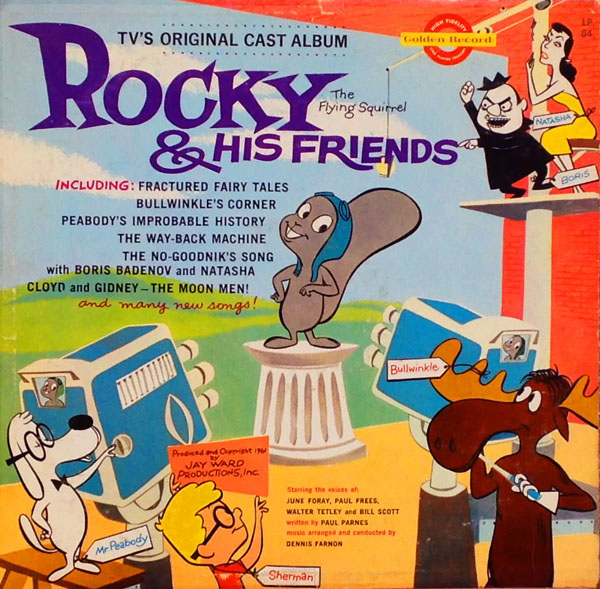
ROCKY AND HIS FRIENDS
TV’s Original Cast Album
Golden Records LP-67 (12” 33 rpm / Mono / 1961)
Little Golden Records #659 (Two Songs: 7” 45 rpm / 6” 78 rpm / Mono / 1961)
Partial Reissue: Wonderland-Golden Records LP- 285 (12” 33 rpm / Mono / 1972)
Released in 1961. Producers: Jay Ward Productions, Arthur Shimkin, Hudson Productions. Writer: Paul Parnes. Arranger/Conductor: Dennis Farnon. Running Time: 34 minutes.
Voices: June Foray (Rocky, Natasha, Red Riding Hood, Grandma); Bill Scott (Bullwinkle, Mr. Peabody, Police Officer; Livingstone, Gidney); Paul Frees (Boris, Police Officer, Ponce DeLeon, Stanley, Cannibal); Walter Tetley (Sherman).
Songs: “I Was Born to Be Airborne,” “I’m Rocky’s Pal,” “Peabody Here!” “The No-Goodnik’s Song,” “I Wanna Go Back,” “Peabody’s History,” “Moon Man Mambo,” “You Gotta Have a Crook,” “Fractured Fairy Tales” by Paul Parnes.
Soundtrack Segments: “Bullwinkle’s Corner: Tom Tom The Piper’s Son;” “Bullwinkle’s Corner: Peter Piper;” “Peabody’s Improbable History: Ponce DeLeon;” “Peabody’s Improbable History: Stanley and Livingstone;” “Fractured Fairy Tale: Ridinghoods Anonymous.”
[The following is revised and enhanced edition of an earlier post.]
When Golden Records was licensing cartoon characters for records from the postwar era through the birth of The Beatles, sometimes they would bring in original cast voices and sometimes it was not possible. In the case of Jay Ward’s classic creations, the album features not only the actors who created the voices, it also presents the characters in a way true to the spirit of the cartoons. In short, it is one of the best cartoon record albums of the era.
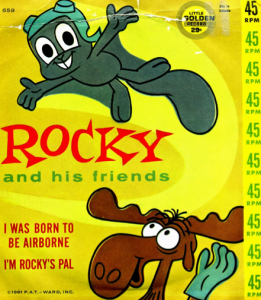 June Foray, Bill Scott, Paul Frees, Walter Tetley, five actual soundtracks, a witty script worthy of Ward and bouncy original songs arranged and conducted by one the show’s musical staff that has the same tone as the series music—and a brisk pace that matches the cartoon style! What more could a Jay Ward fan want?
June Foray, Bill Scott, Paul Frees, Walter Tetley, five actual soundtracks, a witty script worthy of Ward and bouncy original songs arranged and conducted by one the show’s musical staff that has the same tone as the series music—and a brisk pace that matches the cartoon style! What more could a Jay Ward fan want?
Well, if one were to quibble, none of the themes or music cues from the actual Ward library are included. When Rocky and His Friends premiered in 1959, it was unlikely that the licenses for commercial recordings were acquired at the time, otherwise the music would have been included. After the fact, it would have been necessary for Golden to purchase these pricey rights and pay musician fees, which would easily exceed the profits of the album itself, which retailed for $1.98 (and usually sold for less in most stores).
Nevertheless, for the average Golden Record of its day, this is a comparatively expensive album. It was recorded in LA, used the actual voice actors and a small orchestra. Add in travel and expenses and you get an album that had to cost much, much more than, say, Golden’s Songs and Games of Fitness with Posture Pete, which consisted of one narrator and a tiny circus calliope.
Prolific New York songwriter Paul Parnes, whose music credits span over four decades and TV jingles include “Snap, Crackle, Pop,” wrote all the songs. Parnes wrote music for many Golden Records in the early sixties (including the highly recommended Hans Christian Andersen’s Fairy Tales told by Danny Kaye).
Though Parnes is credited as writer, the reflexive fourth-wall humor that constantly calls attention to the recording (“And now, ten seconds of needle scratch…”) suggests that Bill Scott and Jay Ward contributed some tweaking.
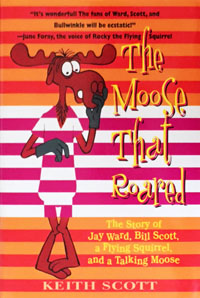 The album must have been in production and release just shy of the title change from Rocky and His Friends to The Bullwinkle Show in 1961. What might surprise some is that the denizens of Frostbite Falls had been on the Jay Ward drawing boards since the early fifties, when he and his early partner, Alex Anderson, were working on Crusader Rabbit. But that’s another story covered in fascinating detail by author/actor Keith Scott in his indispensable, comprehensive book entitled Jay Ward Productions, The Moose That Roared: The Story of Jay Ward, Bill Scott, a Flying Squirrel and a Talking Moose.
The album must have been in production and release just shy of the title change from Rocky and His Friends to The Bullwinkle Show in 1961. What might surprise some is that the denizens of Frostbite Falls had been on the Jay Ward drawing boards since the early fifties, when he and his early partner, Alex Anderson, were working on Crusader Rabbit. But that’s another story covered in fascinating detail by author/actor Keith Scott in his indispensable, comprehensive book entitled Jay Ward Productions, The Moose That Roared: The Story of Jay Ward, Bill Scott, a Flying Squirrel and a Talking Moose.
Animator and story artist Alex Anderson and Jay Ward were college friends. In the late forties, Anderson was working at Terrytoons in New York for his uncle—Paul Terry. It was the late forties when Anderson suggested to Terry that they experimenting with TV animation. Terry was not interested (and knew that their contracted studio, 20th Century-Fox, was opposed to TV, as were all the major studios), but he was supportive.
Anderson eventually teamed with Ward in California to create what became Crusader Rabbit in 1950. Sometime around 1951, they had a pitch for another series called Frostbite Falls Review, which featured among its characters a flying squirrel and a “French-Canadian moose.” Some scripts were prepared along with the board, but the series did not sell. After legal problems hopelessly entangled Crusader Rabbit, they turned to the Frostbite Falls characters.
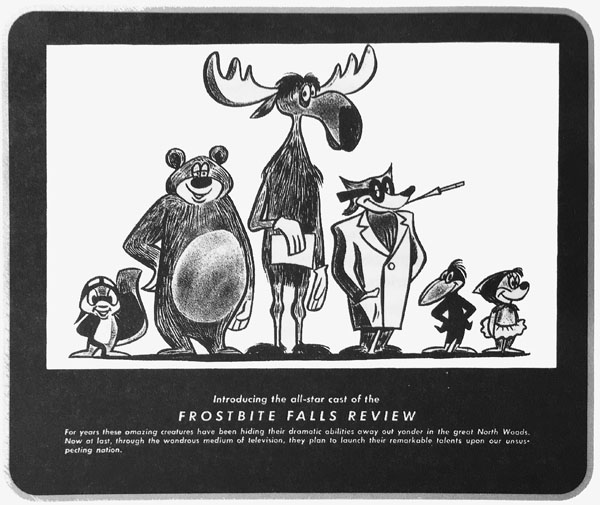
There are many more fascinating details in Scott’s book, but in short, Anderson went into a lucrative (and to his mind more secure) career in advertising, though he consulted with Ward on the development of the eventual Rocky and His Friends series. His brand of pun-tastic, two-tiered humor that poked fun at the pompous was a perfect match for the irreverence of Ward, Bill Scott, the writer, artists and actors who made the cartoons so well-loved and long-lasting.
“I Was Born to Be Airborne” (VOCAL) – June Foray as Rocky
This recording opened the ceremony when the life, career, heart and soul of June Foray was celebrated at the Samuel Goldwyn Theater on September 19, 2017.
“I Was Born to Be Airborne” (INSTRUMENTAL) – Dennis Farnon Orchestra
Because it does not have Frees’ intro and the sound effect pauses, arranger/conductor Farnon was able to create a slower instrumental version in the same time frame as the vocal version. Note that the musicians do not pause at all for the swooping sound effects, but play through smoothly.
CAUTION! MEN SWINGING and THE ENCHANTED WOODS
Dennis Farnon and His Orchestra
Vocalion Records (England) CDNJT-5312 (Compact Disc / 2010)
Remastered by Michael J. Dutton
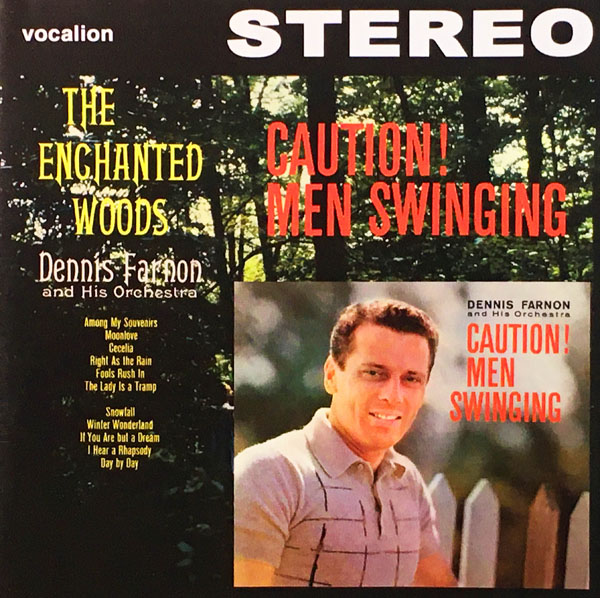
CAUTION! MEN SWINGING: Originally Released in 1957 on RCA Victor Records as LPM-1495 (Mono) and reissued in 1959 in Stereo as LSP-1495. Producer: Dick Peirce. Recorded in Hollywood in 1956. Running Time: 37 minutes.
Music: “Caution! Men Swinging,” “Resume Speed” by Dennis Farnon; “Spring Will Be a Little Late This Year” by Frank Loesser; “Lover Come Back to Me” by Oscar Hammerstein II, Sigmund Romberg; “Just You, Just Me” by Jesse Greer, Raymond Klages; “Isle of Capri” by Will Grosz, Jimmy Kennedy; “South of the Border” by Michael Carr, Jimmy Kennedy; “It Don’t Mean a Thing (If It Ain’t Got That Swing)” by Duke Ellington, Irving Mills; “Why Don’t You Do Right” by Kansas Joe McCoy, Herb Morand; “Three Little Words” by Harry Ruby, Bert Kalmar.
THE ENCHANTED WOODS Originally Released in 1959 on RCA Victor Records as LPM-1897 (Mono) and LSP-1897 (Stereo). Producer: Dick Peirce. Recorded in Hollywood, May 9 and 22, 1958. Running Time: 44 minutes.
Music: “Among My Souvenirs” by Horatio Nicholls and Edgar Leslie; “Moonlove” by Andre Kostalanetz, Mack Davis and Mack David; “Cecelia” by Harry Ruby and Dave Dreyer; Right As The Rain” by Harold Arlen and E.Y. Harburg; “Fools Rush In” by Johnny Mercer and Rube Bloom; The Lady is a Tramp” by Richard Rodgers and Lorenz Hart; “You Are Too Beautiful” by Richard Rodgers and Lorenz Hart; “Snowfall” by Claude Thornhill; “Winter Wonderland” by Felix Bernard and Richard Smith; “If You Had But a Dream” by Nat Bonx, Moe Jaffe and Jack Fulton; “I Hear a Rhapsody” by George Fragos, Jack Baker and Dick Gasparre; “Day by Day” by Sammy Cahn, Axel Stordahl and Paul Weston.
Versatile, idiosyncratic UPA and Jay Ward composer Dennis Farnon, as we have explored back on Mister Magoo’s birthday), was also an accomplished recording artist. This British release combines two classic RCA Victor albums from the golden days of high-fidelity and “Living Stereo,” when the home entertainment center was all about how cool it was to hear things coming from different parts of the living room.
 On the surface, both Caution! Men Swinging and The Enchanted Forest look like typical easy listening instrumental albums of the Eisenhower/Kennedy era. And for the most part, they provide pleasant instrumental music for relaxation or background enjoyment.
On the surface, both Caution! Men Swinging and The Enchanted Forest look like typical easy listening instrumental albums of the Eisenhower/Kennedy era. And for the most part, they provide pleasant instrumental music for relaxation or background enjoyment.
What makes these a little different is that they occasionally dip into the deep end of the crazy pool. On the whole, Caution! Men Swinging is essentially a light pop-jazz album in the Doc Severinsen-Tonight Show with Johnny Carson vein. However, “Isle of Capri” goes into a strange, lighthearted discord, staying somehow within the confines of a “respectable” arrangement.
The Enchanted Forest offers a romantic respite from suburban stress. Two selections stand out from the rest of the album—“Winter Wonderland” and especially “Cecilia”—with their the bouncy, silly feel of a classic Jay Ward music cue. Yet they somehow still fit in among the rest of the more lush, elegant selections. It takes real skill to make this work as a whole.
The Enchanted Woods is also notable for Farnon’s decision to use only woodwinds to showcase their versatility. While you’ll hear percussion and rhythmic touches, it’s all about the enchanted woodwinds, folks.
Farnon’s family is linked to animation through two of his nieces. Shannon Farnon voiced Wonder Woman on Hanna-Barbera’s Superfriends and Darleen Carr was “That Girl” in Walt Disney’s The Jungle Book. His other niece was Charmian Carr, who played Liesl in 1965’s The Sound of Music. His older brother Robert was also a renowned musical director and composer (so it’s sometimes easy to get the two confused, as they both show up on numerous albums).
“Cecilia”
One of the two whimsical arrangements on The Enchanted Woods, this track combines the Jay Ward/Rocky & Bullwinkle sound with a jaunty, David Seville style familiar from The Alvin Show.


 GREG EHRBAR is a freelance writer/producer for television, advertising, books, theme parks and stage. Greg has worked on content for such studios as Disney, Warner and Universal, with some of Hollywood’s biggest stars. His numerous books include Mouse Tracks: The Story of Walt Disney Records (with Tim Hollis). Visit
GREG EHRBAR is a freelance writer/producer for television, advertising, books, theme parks and stage. Greg has worked on content for such studios as Disney, Warner and Universal, with some of Hollywood’s biggest stars. His numerous books include Mouse Tracks: The Story of Walt Disney Records (with Tim Hollis). Visit 





















































The only comment I can say that the Dennis Farnon album “Caution ! Men Swinging” is that the mono and stereo issue were taken from different takes through out.
This is something that happened in the early stereo days. There are several RCA. Columbia & Capitol (and maybe others) were issued better selling album album starting in 1958 in stereo and in some cases the recording or issuing performances original recorded in mono or issued in early Stereo Tapes (usually in paschal albums) were issued to the audiophiles of the time at very high costs,
One of the better-known examples of different mono and stereo versions of the same album was “Exotica,” by Martin Denny on Liberty Records. The original mono version included Arthur Lyman on vibraphone; Lyman had left Denny’s group by the time Liberty decided they needed a stereo remake, so on the stereo album it’s Julius Wechter (later leader of the Baja Marimba Band) on vibes. (In both cases, “good vibes”…)
Dennis Farnon used a lot of bitonality in his scores to enhance comic effect. I bet he even had two keys to his front door! (music theory joke)
When I saw “Just You, Just Me” on the track listing of “Caution! Men Swinging”, I had to look it up online. Unfortunately I don’t think Farnon’s overblown, Vegas-style arrangement really suits the song. I’ve loved it ever since I first heard it in the final scene of “The Groove Tube”, in which star Ken Shapiro, wearing a pink suit and carrying a briefcase, exuberantly sings and dances to it amid the apathetic city crowds. Just thinking about that scene cracks me up. Nat King Cole recorded a great version of it, Doris Day a pretty bad one, but an early recording by Cliff Edwards is simply beautiful — Ukulele Ike at his sentimental best.
Keith Scott last year appeared with Billy West on the online show about entertainment Stu’s Show and was incredible. He is working on a definitive book on classic cartoon voice artists.
https://vimeo.com/340630200
Oh, this is a fantastic article. I’d love to hear more of these recordings.